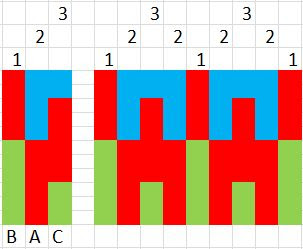Latest update - check out Krokbragd #4 for images of the warping pattern with actual yarn.
It has been a head-scratching week here at KiniB. Trying to make sense of the various Krokbragd instructions across various books and websites. I think I've got my head around it but if anyone spots a mistake hopefully they'll let me know.
I have based my research on the warping pattern from Yarn in my Pocket. Back slot to front slot is shaft (weft thread colour) #1. Back slot to front hole is colour #2 and back hole to front slot is colour #3. There are twice as many #2 warp threads to create the repeat in pattern 1-2-3-2, 1-2-3-2...
Remember - in Krokbragd the warp is completely covered by the weft so it can be of any colour and would, I expect, normally be one colour. For clarity, so you can see which thread goes where, three colours are used in the diagram.
I chose the 2&3...1&3...1&2...1&3 (1... 2... 3... 2...) lift pattern as a baseline, because that seemed to produce the most consistent results when testing patterns. Putting that together with the warping shown gave me the lifting and shed sequence shown below. Note that while that looks like four separate movements there are only three movements involved. The 1&3 repeats are created in one pass of the weft.
Now lets add some weft colours. We'll use blue, red and green in that order.
Lifting both heddles (2 & 3) and passing the weft creates a pattern pixel of weft colour A (blue).
Lowering the front heddle (1 & 3) and passing the weft creates a pattern pixel of weft colour B (red).
Lowering the back heddle (1 & 2) and passing the weft creates a pattern pixel of weft colour C (green).
The next step was to map the instructions from other Krokbragd resources onto this pattern. The results are as shown below. The different order of lifts means that if we use the weft colours A (blue), B (red) and C (green) in the same order for each set of instructions, they will appear in different parts of the four pixel/warp wide pattern.
For example. Yarn in my Pocket starts the sequence with shafts 1 and 2 lifted, opening shed 3. So when we pass the blue weft it will appear in shaft position three of the pattern. Next in the sequence shed 1 is opened so the red weft will appear in the first position. Finally both heddles are raised to open shed 2 which gives two green threads. The resulting four column thread pattern is shown below each table.
If we apply this logic to a simple pattern it is easier to see the effect of these different mappings. In the top row we have, to the left, the original pattern using the sequence described by Ask the Bellwether. To the right is the same pattern using the shed sequence from Yarn in my Pocket.
In the second row are the patterns based on the sequences in "The Wheel" and in the booklet "Krokbragd and Boundweave: Three, Four and Five Shafts" (also known as "Blended Draft for Krokbragd" by David Xenakis).
It should be noted that in David's book he uses a different warping pattern, as shown below. Notice how the repeated thread corresponds to the Slot - Slot warps.
I don't know if anyone else will find this piece of research useful, but it has really helped me to think through how Krokbragd patterns are constructed and how one small change in lifting order can completely change the way the pattern appears when woven.
If you would like a copy of the spreadsheet, you can download it here
Do let me know if you've found it helpful.











7 comments:
Thank you so much for doing the research and posting what you discovered and figured out. I was experiencing the same "WOW its fantastic but how did I do that" moments. I have finally had that eureka moment and I thank you.
Thank you, Yarn Cloud. I'm so pleased you found it useful.
This is so helpful - thank you! One question; when you say to lower the front heddle, then on the next pass to lower the back heddle, is the one that's not lowered in neutral or still raised?
Thank you so much! Just one question; when you say to lower the front heddle, and then for the next pass lower the back heddle, is the other one in neutral or still raised?
Thank you so much for all your hard work on researching this! Your spreadsheet is also amazing!
Yes. Apart from when both heddles are in the raised position there will be one lowered heddle and one in the neutral position.
Thank you, Deb. So pleased you found it useful.
Post a Comment